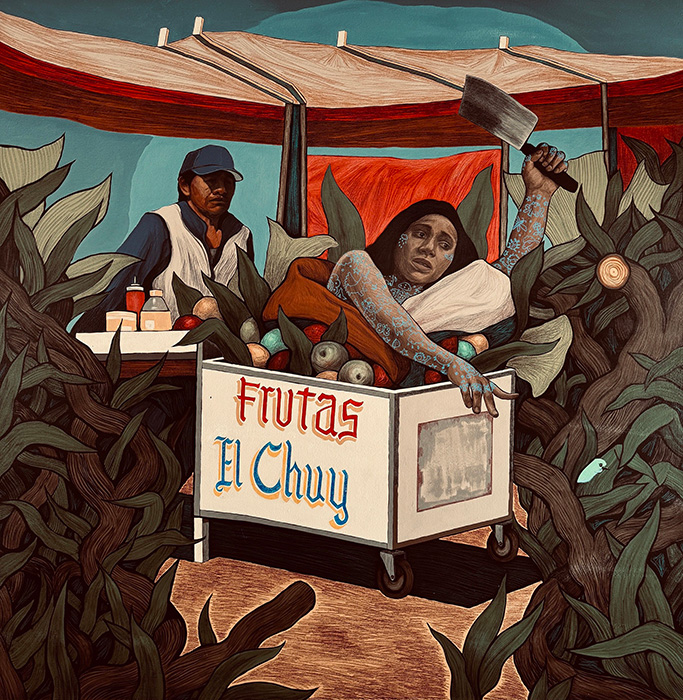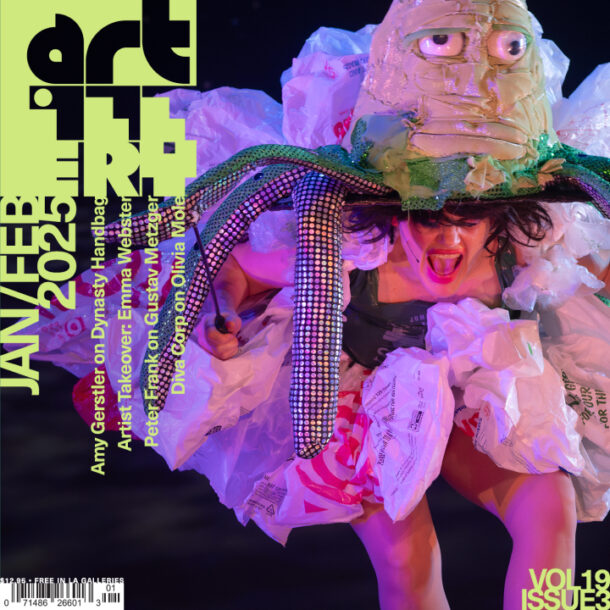
Hugo Crosthwaite: Ex-voto, brings together a new series of large-scale paintings and multi-panel mural on canvas—a prolific endeavor that continues his commitment to visualizing the many myths, narratives, and dynamics of his native Tijuana, Mexico. The exhibition’s title pays homage to Mexican ex-votos, a folk art genre originating from a synthesis of European and Mesoamerican traditions. “Ex-voto,” from the Latin ex voto suscepto (meaning “from the vow”), denotes a painting or object expressing gratitude through depictions of answered prayers and miracles. Ex-votos typically portray petitioners dramatically situated within scenes of their dilemmas, where divine beings intervene unexpectedly from the spiritual realm.
These earnest, dream-like, and surreal compositions have inspired Crosthwaite’s latest body of work. He paints the true stories, miracles, and vows of Tijuana residents, portraying them as icons of resilience and perseverance. Long known for his trademark black-and-white palette, these new paintings mark an important shift as color becomes a primary element in conveying a new spectrum of experiences within a narrative populated by heroines and modern-day saints forging their way through collapsing systems, both literally and figuratively. Crosthwaite resists simplistic interpretations and dismantles frameworks of hierarchy, class, and politics, altering power dynamics to evoke the complexities and in-between-ness of the border city.
The paintings offer a captivating contrast in composition. They juxtapose the fluid shapes of the human form with the sharp, angular lines of architecture. This serves as both a tribute to the city’s unique urban landscape, characterized by its stacked and tiered hillside homes, and a skillful exploration of cubism’s ability to represent multiple viewpoints simultaneously. He also indulges in wordplay, broadening his social critique to encompass the mechanisms of capitalism by interrupting the scene’s intrusive advertisements at points that reveal dual meanings and puns. This is complemented by a variety of ominous visual symbols, such as Coca-Cola bottles, roosters, spirits, and skulls. The vernacular is transformed into allegory as Crosthwaite utilizes symbols of memento mori and vanitas, serving as a timeless yet urgent reminder of humanity’s common ground.
For 25 years, Hugo Crosthwaite has cultivated a radical storytelling practice, bringing hard truths, journeys, dreams, and struggles of everyday people, crossing and living along one of the world’s most traversed international borders. Attracting travelers from all populated continents, the San Ysidro Port of Entry and the metropolis of Tijuana offers ample narratives, from the myths and stereotypes circulated by foreigners, to the hopes of those looking for opportunities in the North, to Americans who visit for affordable goods, medical tourism, cultural diversions, as well as the exploitive underbelly of the market for contraband and sex tourism—what the artist calls “cannibal tourism.” Crosthwaite’s documentary approach has included recordings of oral histories, live-sketch graphite portrait drawings, murals and animations to capture stories that often go untold in a region shaped by constant flux.
Hugo Crosthwaite (b. 1971, Tijuana, BC, MX) lives and works between Rosarito, BC, MX, and San Diego, CA, US. He holds a BA in Applied Arts from San Diego State University. Crosthwaite was awarded First Prize in the 2019 Smithsonian National Portrait Gallery’s Outwin Boochever Portrait Competition for his stop-motion animated video A Portrait of Berenice Sarmiento Chávez, and subsequently the portrait commission for Dr. Anthony S. Fauci, another stop-motion animation portrait that debuted at the NPG in 2021. Other awards include the 2021 San Diego Art Prize and the Grand Prize at the 2014 XI FEMSA Monterrey Biennial, MX. Crosthwaite’s works are included in the permanent collections of the Smithsonian National Portrait Gallery, Washington, D.C.; Morgan Library and Museum, New York; Los Angeles County Museum of Art; Orange County Museum of Art, Costa Mesa, CA; Museum of Contemporary Art, San Diego, CA; San Diego Museum of Art, CA; National Museum of Mexican Art, Chicago, IL; Museum of Latin American Art, Long Beach, CA; Boca Raton Museum of Art, FL; University of Arkansas Art Gallery, Little Rock, AK; FEMSA Collection, Mexico City; CECUT/Centro Cultural Tijuana, Mexico; and private collections in the U.S. and around the world.

